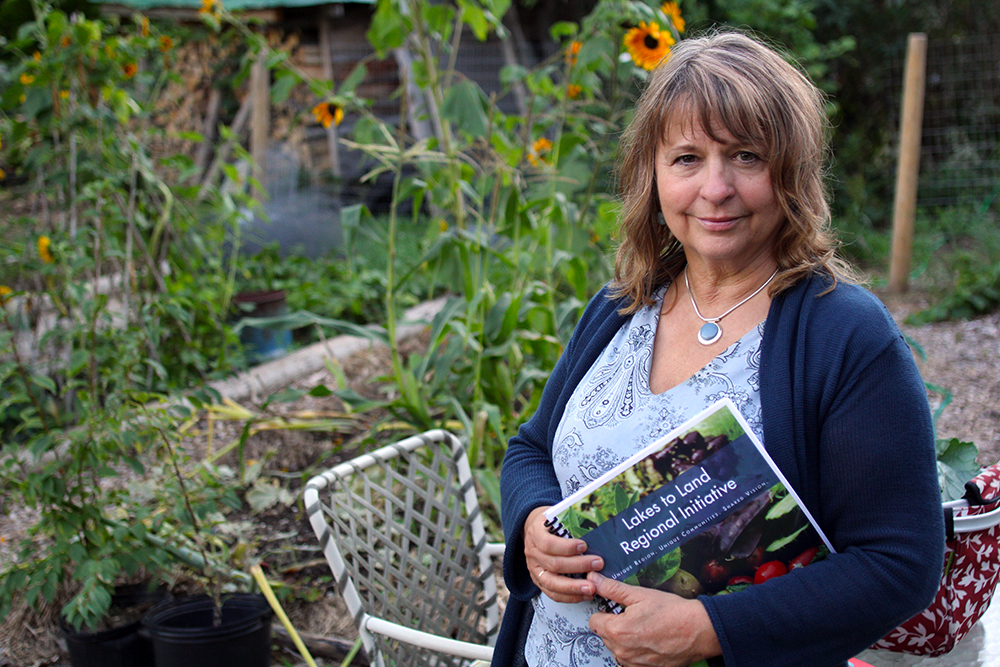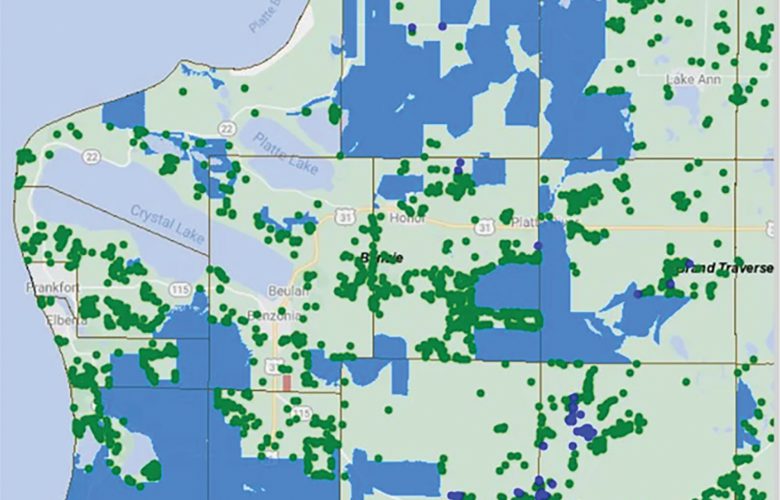Thoughts on the local harvest
Today for breakfast I ate fruit salad, consisting of blueberries from the Grow Benzie farmers market, apples and peaches from Brown’s Orchard, topped with goat’s milk yogurt from a local farm, and washed it down with several cups of Higher Grounds coffee. Why can’t I — why can’t we all — eat like this every meal? That is the bedrock question addressed in “Farm and Food System Assessment”, a thorough report that’s currently in draft form, generated under the auspices of the Lakes to Land Regional Initiative (L2L). The endeavor frames the project more broadly in terms of the nuts and bolts of food production, processing, distribution, and consumption in the western portions of Benzie and Manistee County.
A Michigan State University intern, Cassi Meitl, guided by Sharron May (Beyond Salon and May Farm) and Betsie Evans (Alliance for Economic Success), worked hard this summer and interviewed representatives from every link that makes up our local food chain. Armed with a set of carefully designed questions, she scoured farmers markets, knocked on barn doors, consulted food processors, spoke with restaurant managers and chefs, tracked down local agricultural supporting organizations and agencies, and talked with emergency kitchen and food bank managers to learn what our local food chain has and what it lacks.
As it turns out, the local food movement is thriving. I love local food but was surprised that I can name only a handful of the 181 farms in Benzie County. Of the more than 7,500 acres in harvested cropland, over 3,000 acres are orchards, explaining why we have so many apples, cherries, and peaches at our markets and in some of our grocery stores. That only nine acres grow berries is amazing since there are so many to pick or buy locally when in season. That’s a good reason to cherish and freeze them. One hundred and four acres produce other food for people; the rest is mostly for feed. There are several well-known large family farms in Benzie County that sell to wholesalers to export nationally and internationally, but 70 percent of the region’s farms are described as “Small Family Farms” (defined by the USDA Economic Research Service as having less than $100,000 in gross annual sales) and primarily sell directly to local consumers.
Besides we eaters who don’t grow our own food, who else is part of the Benzie County food chain? To name a few, Benzie County has five farmers markets; at least five grocery stores that carry local food; two large food processors plus numerous small ones, some classified as cottage industries; at least six restaurants that source locally; an incubator kitchen; six food pantries, and a community garden. A lot.
But this food chain has weak links. People from small, medium (grossing $100,000-$250,000) and large farms all want to increase production. Not surprisingly, the barriers to greater production differ for different sized farms, but some commonalities exist. They ALL want better cell phone coverage and Internet service (a tie that apparently binds us all). All cite better access to utilities, with the mid- and large-size farms stressing three-phase wiring and natural gas. They all want more labor, though in different forms. The largest farmers want a full-fledged guest worker program; the small farms want interns; and the mid-sized want skilled help. They all want access to Individually Quick Frozen (IQF) facilities. They all want government to ease up on time-consuming regulations. They all want help with marketing and advertising.
And they would all like us to eat more. Local food, that is. While the interest in, and capacity to supply, food on a larger scale differs across the different sized farms, the mid- and small-sized farms would like to be less dependent on selling one piece of fruit or bunch of carrots at a time and scale up to be able to provide more to restaurants, grocery stores, and institutions such as schools and food banks. For those operating small and mid-sized farms, being able to supply more institutions (hospitals, schools, daycare facilities,) and restaurants would be a great boost. There are several substantial barriers. First, these farmers are busy farming and have little time to form necessary relationships within this portion of the market except on an ad hoc basis. Second, many in that consumer group struggle to cope with an uneven availability and quality. Even using consistent farming techniques, growing conditions are changeable and not within the farmer’s control. Also there can be substantial transportation costs that limit market scope.
The L2L report provides rich descriptive information and a far more comprehensive analysis of the needs, barriers, and solution strategies that are touched on here. When the report is ready for final release, look for it to give an excellent picture of the local food chain.
Now back to the consumer who wants healthy local food on the table every day. Hopefully some day, access to locally produced food will be commonplace. Until then, how do we do our part? One thing is to continue doing what we are doing: going to farmers markets, looking for the “local” sign in front of produce at grocery stores, participating in Community Supported Agriculture (CSAs), and eating at restaurants that buy local. We can preserve food to eat in the offseason. For those of us who didn’t learn how to can at our mother’s knee, Grow Benzie offers lots of classes on cooking and preserving. Tim Young, owner of Food for Thought, swears by Greene, Hertzberg, and Vaughan’s Putting Food By, and pretty much all of us have freezers.
The Betsie Current wants to help. We are issuing the “Local Food Holiday Challenge”, because Thanksgiving is sooner than we think (followed quickly by Christmas). Local products make good gifts, and why not get your holiday shopping done early). The Betsie Current seeks locally sourced Thanksgiving recipes and menus. Please email them to editor@betsiecurrent.com or mail to: The Betsie Current, P.O. Box 90, Frankfort, MI 49635. We’ll include at least some of them in our Nov. 13 “Holidays” issue (and more on our website, BetsieCurrent.com). Including the food source would be helpful. “Taste the Local Difference”, a directory of local producers, is available at the Michigan Land Use Institute website (Mlui.org) to help identify farmers and other sources. A local food dish at your Thanksgiving dinner would give you and everyone along the Benzie County food chain one more thing to be thankful for.
Banner photo: Sharron May in her garden. Photo by Aubrey Ann Parker.




